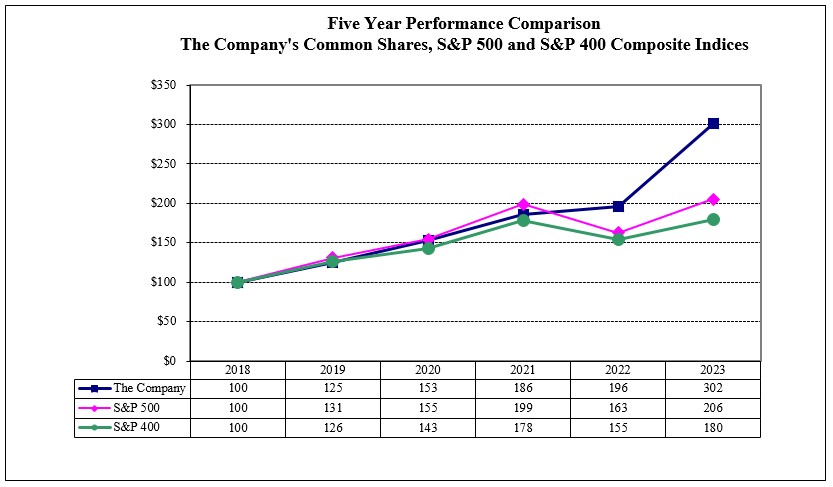As of December 31, 2023, there were $12,592 of tax liabilities related to unrecognized tax benefits and a $53,628 liability for deferred compensation. Because of the high degree of uncertainty regarding the timing of future cash outflows associated with these liabilities, the Company is unable to estimate the years in which settlement will occur.
Stock-Based Compensation
On April 19, 2023, the shareholders of the Company approved the 2023 Equity and Incentive Compensation Plan ("2023 Employee Plan"), which replaced the 2015 Equity and Incentive Compensation Plan (“2015 Employee Plan”). The 2023 Employee Plan provides for the granting of options, appreciation rights, restricted shares, restricted stock units and performance-based awards up to an additional 2,025,000 of the Company’s common shares. In addition, on April 19, 2023, the shareholders of the Company approved the 2023 Stock Plan for Non-Employee Directors ("2023 Director Plan"), which replaced the 2015 Stock Plan for Non-Employee Directors (“2015 Director Plan”). The 2023 Director Plan provides for the granting of options, restricted shares and restricted stock units up to an additional 200,000 of the Company’s common shares. At December 31, 2023, there were 2,192,720 common shares available for future grant under all plans.
Under these plans, the number of options, restricted shares and restricted stock units granted were 241,824 in 2023 and 284,946 in 2022. The Company issued common shares from treasury upon all exercises of stock options, vesting of restricted stock units and the granting of restricted stock awards in 2023 and 2022.
Total stock-based compensation expense recognized in the Consolidated Statements of Income for 2023 and 2022 was $26,223 and $25,276, respectively, with a related tax benefit of $6,711 and $6,363, respectively. As of December 31, 2023, total unrecognized stock-based compensation expense related to non-vested stock options and restricted stock units was $17,254, which is expected to be recognized over a weighted average period of approximately one year.
The aggregate intrinsic value of options outstanding and exercisable, which would have been received by the optionees, had all awards been exercised at December 31, 2023 was $99,884 and $82,057, respectively. The total intrinsic value of awards exercised during 2023 and 2022 was $35,414 and $7,082, respectively.
Product Liability Costs
Product liability costs incurred can be volatile and are largely related to trial activity. The costs associated with these claims are predominantly defense costs which are recognized in the periods incurred.
The long-term impact of product liability contingencies, in the aggregate, on operating results, operating cash flows and access to capital markets is difficult to assess, particularly since claims are in many different stages of development and the Company benefits significantly from cost sharing with co-defendants and insurance carriers. Moreover, the Company has been largely successful to date in its defense of these claims.
Off-Balance Sheet Arrangements
The Company utilizes letters of credit to back certain payment and performance obligations. Letters of credit are subject to limits based on amounts outstanding under the Company’s Credit Agreement.
New Accounting Pronouncements
Refer to Note 1 to the consolidated financial statements for a discussion of new accounting pronouncements.
Critical Accounting Policies and Estimates
The Company’s consolidated financial statements are based on the selection and application of significant accounting policies, which require management to make estimates and assumptions. These estimates and assumptions are reviewed periodically by management and compared to historical trends to determine the accuracy of estimates and assumptions
